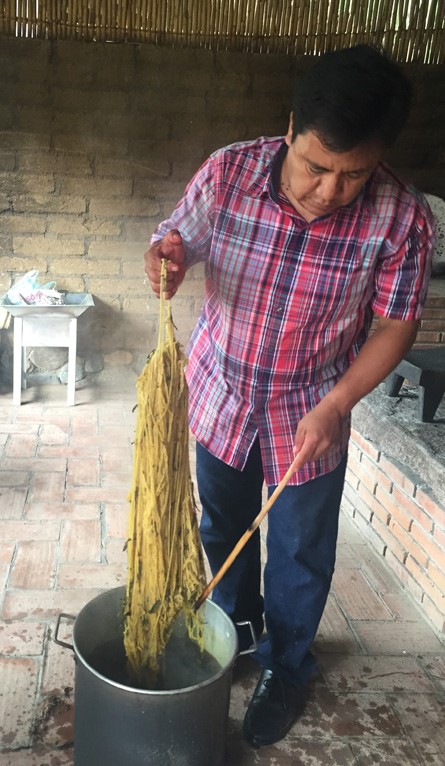Dye Terminology: Pigments and Dyes
Pat Slaven
Craft dyers come upon a lot of dye terminology that can make our dyeing lives easier or harder. It all depends on understanding and interpreting how the terminology relates to the project and dyes you are using. This column is specific to technical definitions of Dyes and Pigments. You will often see these two descriptions used interchangeably. However, there are technical definitions for 'Dyes' and 'Pigments'.
The Society Of Dyers And Colourists, in association with the American Association of Textile Chemists and Colorists (AATCC ) define Dyes as intensely colored organic substances only, which impart color to a substrate by selective absorption of light. They are soluble and/or go through an application process which destroys (at least temporarily) any crystal structure by absorption, solution and mechanical retention or by ionic or covalent chemical bonds. Dyes form a chemical reaction with the fiber.
Natural dyes are technically Dyes by definition. They dissolve into solution and form a chemical reaction or bond with a fiber assisted by mordents and auxiliaries or they get lodged in the fiber structure. We rarely classify natural dyes in the categories commonly seen with synthetic dyes, such as Acid, Direct, Vat or Dispersed dyes, but they too have functional chemical groups to aid in reacting with the fiber or mordent and often bridge dye classes.
On the other hand, Pigments are defined as colored particulate organic or inorganic solids which are usually insoluble in, and essentially physically and chemically unaffected by, the vehicle or substrate in which they are incorporated. Pigments are usually dispersed in vehicle or substrates for application, as for instance in the manufacture of inks, paints, plastics or other polymeric material. Pigments retain a crystal or particulate structure throughout the coloration process.
Pigments are chemically inert and do not have available reactive groups to connect the color to the fiber or other surface. Pigments need a mechanical means to attach to fiber–an adhesive or carrier to apply it to a surface. Natural pigments (e.g., lapis, ochre, turquoise, malachite, and cinnabar) are minerals or clays and can be mixed with a carrier to make paints. Yes, one can use a carrier or adhesive (think puffy fabric paint from a mass market craft store or a glue gun) but craft dyers rarely use these means to attach pigments to natural fibers.
Indigo is the one natural 'Dye' that straddles the two definitions. It can be used as a pigment for paints and ink and as a dye for textiles. The pigment, Indigotin, is inert and can be ground for use in paints and ink. The dye, as we all too well know, is formed by a process of coaxing it into a solution, stripping oxygen out using fermentation or reduction and then saturating fiber with the solution and oxidizing it as the fiber contacts air on exiting the dye pot. We see a greenish solution in the dye pot with the famous blue scum on the surface. The surface particles are inert, insoluble and do not impart permanent color to the fiber. The indigo can be considered a dye because the structure has gone into solution and is no longer crystalline. The reaction with oxygen converts the reduced soluble indoxyl or leuco-indigo to insoluble blue indigo 'stuck' inside the fiber.
For once you can dither on calling indigo a dye or a pigment: it all depends on how you are using it and where you are in the process.
Happy dyeing, Pat Slaven
References:
"Definitions of a dye and a pigment". https://colour-index.com/definitions-of-a-dye-and-a-pigment.
Jenny Balfour-Paul, 1998. Indigo. British Museum Press, London.
Pat Slaven is a Chemical Engineer and Textile Chemist who worked for a carpet care trade association and later for Consumer Reports. She is an occasional contributor to Shuttle Spindle & Dye Pot, is active in the Handweaver's Guild and her local knitting guild. And yes, she dyes a lot of fiber.
If you have ideas for future Dye Terminology columns, please forward them to Pamela Feldman at madder@comcast.net.
 Turkey Red Journal
Turkey Red Journal
